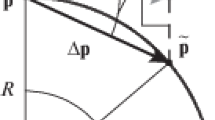Abstract
Using the 99942 Apophis asteroid (currently known as one of the most dangerous asteroids that is approaching the Earth) as an example, we estimate the error of predicting its motion with the use of several integrators over the time interval from 2012 to 2029. The minimum distance (and its error) between the Earth’s center and Apophis was estimated for the rendezvous moment on April 13, 2029. It is shown that this error for various integrators is comparable in the order of magnitude with the influence of certain components of the dynamic model of motion, such as, for example, the influence of harmonics of the Earth’s gravitational filed, solar-light pressure, the Jarkowski effect, etc.
Similar content being viewed by others
References
Bakhvalov, N.S., Zhidkov, N.P., and Kobel’kov, G.M., Chislennye metody (Numerical Methods), Moscow: Nauka, 1987.
Bashakov, A.A., Pit’ev, N.P., and Sokolov, L.L., Peculiarities of motion of the asteroid 99942 Apophis, Astron. Vestn., 2008, vol. 42, no. 1, pp. 20–29.
Bordovitsyna, T.V., Sovremennye chislennye metody v zadachakh nebesnoi mekhaniki (Modern Numerical Methods in Problems of Celestial Mechanics), Moscow: Nauka, 1984.
Vinogradova, T.A., Kochetova, O.M., Chernetenko, Yu.A., et al., Orbit of Apophis (99942) asteroid as determined from optical and radar observations, Astron. Vestn., 2008, vol. 42, no. 4, pp. 291–300.
Grushinskii, N.P., Osnovy gravimetrii (Principles of Gravimetry), Moscow: Nauka, 1983.
Duboshin, G.N., Spravochnoe rukovodstvo po nebesnoi mekhanike i astrodinamike (Handbook on Celestial Mechanics and Astrodynamics), Moscow: Nauka, 1976.
Smirnov, E.A., Modern numerical methods of integrating the equations of motion of asteroids approaching the Earth, in Okolozemnaya astronomiya 2007 (Near-Earth Astronomy 2007), Nal’chik: Izd. M.i V. Kotlyarovy, pp. 54–59.
Smirnov, E.A., Prediction of the orbit of Apophis asteroid: the role of integrators, Vestnik SibGAU, 2011, pp. 43–45.
Tatevyan, S.K., Sorokin, N.A., and Zaletkin, S.F., Numerical integration of ordinary differential equations on the basis of local polynomial approximations, Vych. Metody i Program., 2000, vol. 1, pp. 28–61.
Shor, V.A., Chernetenko, Yu.A., Kochetova, O.M., and Zheleznov, N.B., Influence of the Jarkowski effect on Apophis orbit, Astron. Vestn., 2012, vol. 2, pp. 131–142.
Armellin, R., Lizia, P.Di., Bernelli-Zazzera, F., and Berz, M., Asteroid close encounters characterization using differential algebra: The case of Apophis, Cel. Mech., 2010, vol. 107, no. 4, pp. 451–470.
Butcher, J.C., Integration processes based on Radau quadrature formulas, Math. Comp., 1964, vol. 18, pp. 233–244.
Chambers, J.E., A hybrid symplectic integrator that permits close encounters between massive bodies, Mon. Not. R. Astron. Soc., 1999, vol. 304, pp. 793–799.
Chesley, S.R., Potential impact detection for near-Earth asteroids: The case of 99942 Apophis (2004 MN4), Proc. of the Intern. Astronomical Union, 2006.
Eggl, S. and Dvorak, R., An introduction to common numerical integration codes used in dynamical astronomy, Lect. Notes Phys., 2010, pp. 431–480.
Everhart, E., Implicit single methods for integrating orbits, Cel. Mech., 1974, vol. 10, no. 1, pp. 35–55.
Giorgini, J.D., Benner, L.A., Ostro, S.J., et al., Predicting the Earth encounters of (99942) Apophis, Icarus, 2008, vol. 193, pp. 1–19.
Hut, P. and Makino, J., A new time-symmetric block time-step for algorithm for N-body simulations, arXiv: astro-ph/0511304, 2005.
Kochetova, O.M., Chernetenko, Y.A., and Shor, V.A., How precise is the orbit of asteroid (99942) Apophis and how probable is its collision with the Earth in 2036–2037, Solar System Research, 2009, vol. 43, no. 4, pp. 324–333.
Laskar, J. and Robutel, P., High order symplectic integrators for perturbed Hamiltonian systems, Cel. Mech., 2001, vol. 80, pp. 39–62.
Makino, J., Optimal order and time-step criterion for Aarseth-type N-body integrators, Astrophys. J., 1991, vol. 369, pp. 200–212.
Moore, C., Braids in classical dynamics, Phys. Rev. Lett., 1993, vol. 70, pp. 3675–3679.
Parker, G.E. and Sochacki, J.S., Implementing the Picard iteration, Neural, Parallel, and Scientific Computations, 1996, vol. 4, pp. 97–112.
Rudmin, J.W., Application of the Parker-Sochacki method to celestial mechanics, Technical Report, James Madison University, 1998.
Yoshida, H., Construction of higher order symplectic integrators, Phys. Lett. A., 1990, vol. 150, pp. 262–268.
Zizka, J. and Vokrouhlicky, D., Solar radiation pressure on (99942) Apophis, Icarus, 2011, vol. 211, pp. 511–518.
Author information
Authors and Affiliations
Additional information
Original Russian Text © E.A. Smirnov, E.I. Timoshkova, 2014, published in Kosmicheskie Issledovaniya, 2014, Vol. 52, No. 2, pp. 125–131.
Rights and permissions
About this article
Cite this article
Smirnov, E.A., Timoshkova, E.I. Comparative investigation of methods for the numerical prediction of motion of asteroids that approach the Earth: Example of the 99942 Apophis asteroid. Cosmic Res 52, 118–124 (2014). https://doi.org/10.1134/S0010952514020075
Received:
Published:
Issue Date:
DOI: https://doi.org/10.1134/S0010952514020075



